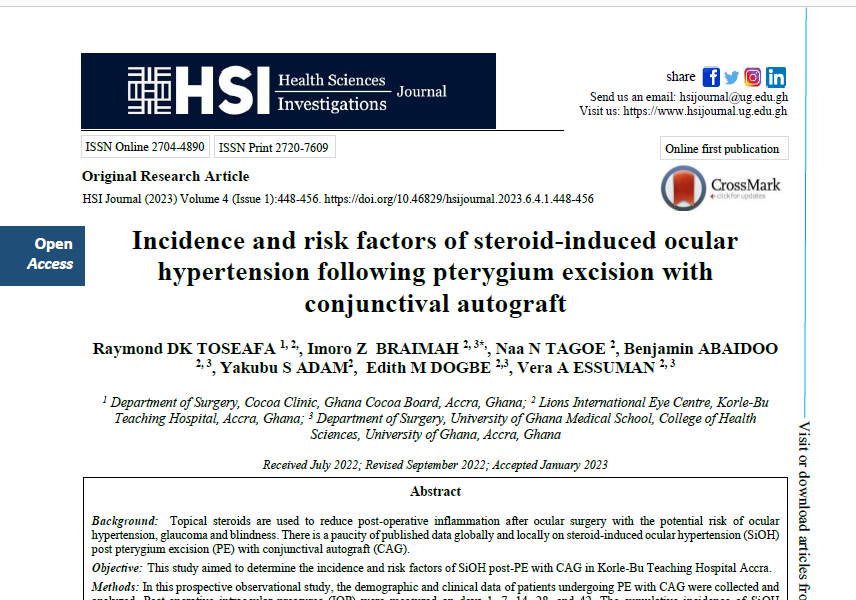Incidence and risk factors of steroid-induced ocular hypertension following pterygium excision with conjunctival autograft
Steroid-induced ocular hypertension
Abstract
Background: Topical steroids are used to reduce post-operative inflammation after ocular surgery with the potential risk of ocular hypertension, glaucoma and blindness. There is a paucity of published data globally and locally on steroid-induced ocular hypertension (SiOH) post pterygium excision (PE) with conjunctival autograft (CAG).
Objective: This study aimed to determine the incidence and risk factors of SiOH post-PE with CAG in Korle-Bu Teaching Hospital Accra.
Methods: In this prospective observational study, the demographic and clinical data of patients undergoing PE with CAG were collected and analyzed. Post-operative intraocular pressures (IOP) were measured on days 1, 7, 14, 28, and 42. The cumulative incidence of SiOH (proportion of the increase in IOP ≥ 10mm Hg at six weeks compared to baseline) and mean change in IOP from baseline were computed. Risk factors of SiOH were determined using a multiple logistic regression model. The Kaplan-Meier survival curve was used in estimating the median time to develop SiOH.
Results: Overall, 101 patients participated in this study with a mean age of 46.8 ± 11.9 years. The majority (65.3%, n= 66/101) of participants were females. The mean pre-operative IOP in the study eyes was 15.3 ± 3.0 mm Hg. The overall mean post-operative IOP was 18.6 ± 2.8 mm Hg (p = 0.001). The overall incidence of SiOH six weeks post-PE with CAG was 32.7% (95% confidence interval (CI) = 23.7 - 42.7%). Male sex was the only independent factor associated with the development of SiOH [odds ratio (OR) = 3.3; 95% CI = 1.1 - 9.7; p = 0.032]. The median time to develop SiOH was 42 days (95% CI = 37.1 - 46.9 days, p = 0.022).
Conclusion: The study showed that SiOH post-PE is a common complication with an overall six-weeks post-excision incidence of 32.7%. Males are more likely to develop SiOH after PE with CAG. Patients undergoing PE with CAG should be closely monitored postoperatively to prevent complications associated with prolonged raised IOP.


